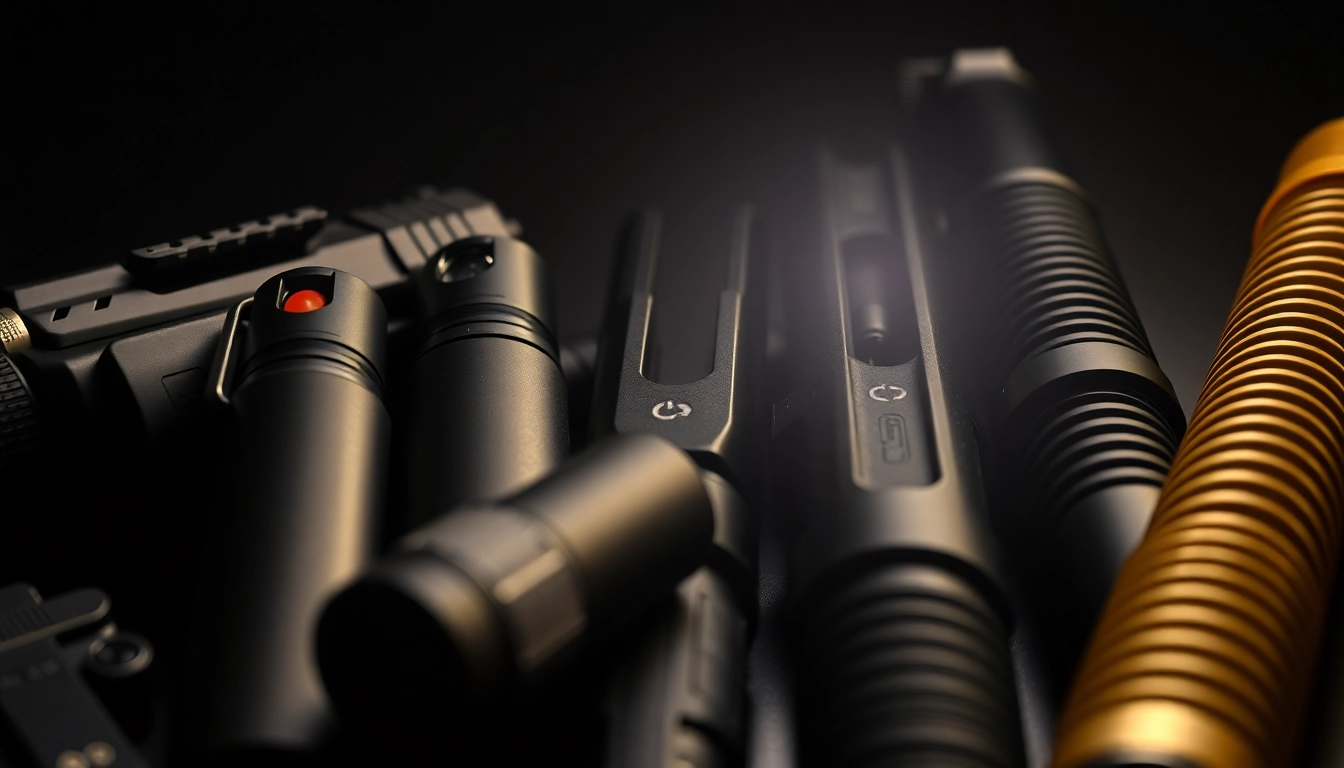Understanding Self-Defense Weapons: Types and Legalities
In today’s world, personal safety has become a paramount concern for many individuals. Whether walking home late at night, commuting through unfamiliar areas, or simply seeking peace of mind, knowing about effective self-defense methods and tools is crucial. Central to this knowledge is an understanding of Self-Defense Weapons, their various categories, legal considerations, and practical applications. This comprehensive guide explores the different types of self-defense weapons, their legality across jurisdictions, and how to select the most appropriate options for your personal protection needs.
Non-Lethal vs. Lethal Self-Defense Weapons
Defining the Distinction
One of the fundamental aspects of choosing a self-defense weapon is understanding the difference between non-lethal and lethal options. Lethal weapons, such as firearms or certain knives, are designed to cause serious injury or death and are generally subject to stricter regulations. They are effective in deterring or stopping an attacker but carry significant legal, ethical, and safety considerations.
Non-lethal weapons, on the other hand, aim to incapacitate or deter an attacker without causing permanent harm. These include pepper spray, stun guns, personal alarms, and other chemical or electric devices. Their primary advantage lies in legal accessibility and reduced risk of severe injury, making them suitable for a wider range of users and situations.
For example, pepper spray and tasers are popular non-lethal options that deliver temporary discomfort or incapacitation, providing a vital window for escape. Many jurisdictions favor non-lethal tools for everyday carry due to their ease of use and lower legal barriers.
Legal Considerations in Different States and Countries
The Complexity of Self-Defense Law
Legal regulations surrounding self-defense weapons vary widely depending on geographic location. While some devices are universally legal, others are restricted or banned entirely. For instance, pepper spray is legal in most U.S. states, but specific restrictions such as spray size or licensing may apply.
Similarly, stun guns are permitted in many states, yet in others, they are classified as prohibited weapons. Firearms are subject to even more rigorous laws, with certain states requiring permits, background checks, and storage protocols.
Internationally, laws can be even more restrictive. In the UK, for example, many self-defense weapons like stun guns are illegal, and carrying concealed blades may require specific permits. In contrast, the United States offers a broader legal spectrum but still mandates awareness and adherence to local statutes.
To navigate this legal landscape, individuals should consult local laws and consult attorney resources. Additionally, always verify whether specific weapons can be legally purchased, carried, and used in self-defense within your jurisdiction.
Choosing the Right Self-Defense Weapon for Your Needs
Assessing Your Personal Situation
The optimal self-defense weapon depends on lifestyle, environment, physical ability, and personal preferences. For example, urban dwellers may prioritize discreet, non-lethal devices, while outdoor enthusiasts or those in high-risk areas might favor more robust options.
Moreover, age, strength, and training level influence suitable choices. For elderly individuals or those with limited mobility, lighter, easy-to-use tools such as personal alarms or compact stun guns may be ideal. Conversely, individuals seeking immediate stopping power might consider legal firearms or expandable batons, provided they are trained in proper handling.
Case studies reveal that combining multiple tools—like carrying pepper spray along with a personal alarm—can maximize safety. Practicality, ease of access, and legal compliance are guiding principles for selection.
Popular Self-Defense Weapons and How to Use Them Effectively
Pepper Spray and Chemical Self-Defense Tools
Pepper spray remains one of the most accessible and effective non-lethal self-defense tools. It temporarily blinds and irritates an attacker’s mucous membranes, providing a critical opportunity to escape. Modern pepper sprays come in compact, pocket-sized containers that are easy to carry and quick to deploy.
To maximize effectiveness, practice aiming at the attacker’s face and ensure the spray is in a ready position. Education on legal limits—such as spray size and restrictions—ensures responsible use.
Tasers, Stun Guns, and Electric Shock Devices
Tasers and stun guns deliver electric shocks that disrupt muscle functions, incapacitating an attacker temporarily. Tasers often fire projectiles embedded in wires, allowing for longer-range targeting, while stun guns are handheld devices used in close combat.
Training in proper aim and handling is crucial to avoid misfire or injury to oneself. Regular practice enhances reflexes and effectiveness, especially under stress. Laws permit their use primarily as defensive tools, and ethical considerations demand respectful application only in genuine threats.
Blades, Batons, and Discreet Carry Options
Traditional weapons such as folding knives, canes, or batons can be highly effective when used legally and responsibly. Discreet carry options like disguised cane swords or lightweight tactical pens allow self-defense without obvious weapon displays, reducing potential legal issues.
Proper training in techniques and local laws is mandatory. For example, using a baton effectively requires practice to avoid accidental injury and to maximize impact during self-defense scenarios.
Safety Tips for Self-Defense Weapon Storage and Handling
Proper Storage to Prevent Accidents
Safe storage of self-defense weapons is critical to prevent accidents, especially in homes with children or visitors. Weapons should be kept in secure cases, out of reach, and clearly labeled. For firearms, this includes lockboxes with key or biometric access.
Chemical sprays and electric devices should be stored in accessible yet secure locations, ensuring quick retrieval without risk of unintended activation.
Training and Practice for Maximum Effectiveness
Regular training is vital—simply possessing a weapon or tool does not guarantee readiness. Enroll in professional self-defense classes, practice deployment techniques, and familiarize yourself with the device’s operation.
Scenario-based drills foster muscle memory, confidence, and appropriate decision-making during high-stress encounters.
Legal and Ethical Use of Self-Defense Weapons
Using self-defense weapons ethically involves proportionality and necessity. Only employ them when faced with an imminent threat, and cease use once the threat is neutralized. Be aware of local laws regarding self-defense and avoid escalation that could lead to legal consequences.
Emerging Trends and Innovative Self-Defense Tools
Smart Personal Alarms and App Integration
Technology integration has revolutionized personal safety. Smart personal alarms now connect to smartphones via apps, allowing users to send instant alerts with GPS coordinates to friends, family, or law enforcement.
Some devices include features like voice-activated alarms or automatic emergency calls, providing rapid response capabilities even in panic situations.
Compact, Discreet, and Multi-Function Devices
Manufacturers develop multi-purpose tools such as keychain devices that combine stun capabilities, alarms, and LED flashlights. Discreet designs ensure that users can carry defense tools inconspicuously, blending with everyday items.
For example, a tactical pen not only writes but also functions as a striking weapon, offering practical multi-functionality.
Future Developments in Self-Defense Technology
Advances in materials, sensors, and AI may produce even smarter self-defense tools. Expected innovations include wearable devices that detect assault attempts and automatically activate alarms or deterrent measures.
Though promising, responsible legal frameworks and ethical considerations will shape their deployment, ensuring safety without infringing on rights or privacy.
Choosing the Best Self-Defense Weapons for Different Users
Self-Defense Weapons for Women
Women often seek lightweight, compact, and easy-to-use devices like pepper sprays, personal alarms, or small stun guns. Stylish, discreet options such as disguised keychains or jewelry-enhanced sprays help maintain a sense of confidence and empowerment.
Training sessions tailored for women can improve situational awareness and proper deployment techniques, boosting effectiveness and peace of mind.
Self-Defense Tools for Men and Seniors
Men and seniors may prefer more substantial tools like expandable batons, tactical knives, or handheld stun devices. Senior-friendly options prioritize ease of access and minimal complexity, with ergonomic designs for comfortable handling.
For seniors, non-violent, low-maintenance devices like personal alarms or canes equipped with discreet self-defense features can be ideal, combining accessibility with protection.
Self-Defense Options for Kids and Teens
For younger users, emphasis should be on safety, responsible use, and legal compliance. Non-lethal items like whistles, personal alarms, or educational self-defense classes are suitable starting points.
It’s essential to involve guardians in training and usage policies, fostering responsible habits and awareness from an early age.



